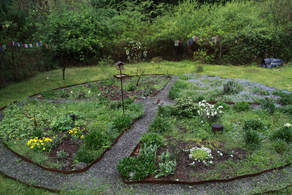|
Ozark Green Thumb BCMG Monthly e-Newsletter |
|
|
 For more than 5,000 years, natives of the Western Hemisphere built sacred cairns surrounded by one or more concentric circles, with spokes or stone lines radiating outward. Based on the number four (representing the cardinal directions and thought to be situated at energy vortexes), sacred circles were used all over the world for ceremonies, as places of worship and to communicate creation stories. Rich in symbolism and powerful as healing places, these edifices stand testament to nature-based and deeply spiritual cultures. Today’s medicine wheel gardens are based on the circle—the sacred natural shape symbolic of the interconnections of all life. Their round designs feature a central focus and four or more paths that carve the garden into pie-shaped beds. Most are planted with perennial and annual herbs, some featuring only medicinal herbs, others encompassing a wide variety of culinary, ornamental, tea, heirloom, cosmetic and healing herbs or indigenous herbs, grasses, shrubs and cacti. Medicine wheel gardens are intensely personal, and one’s choice of plants, materials and symbolic ornaments reflects the inner garden of the spirit. To create a medicine wheel, gather five marker stakes, a hammer, measuring tape, compass and some string or lime. Rocks mark the important yearly dates around the outside circle (see diagram below), so a good-size rock pile also would be handy. To start the wheel, drive a stake into the ground at the desired center point. Using a compass, locate the four cardinal directions and mark each with a stake 4 feet from the center. Mark the circle by joining the four cardinal direction stakes with string. Once the circle is marked, prepare the circle as you would any herb bed. If the site is on a lawn, till or dig out the sod, being careful to keep the five stakes in place. Mix in peat or compost, a small amount of bone meal (or lime or wood ash) and topsoil. In general, herbs tolerate a wide range of conditions but prefer well-drained, slightly alkaline soil. Lay 24-inch-wide heavy plastic landscaping cloth from each directional stake toward the center to form paths. Spread gravel, shells, wood chips or other natural material over the plastic and replace the four directional stakes with large rocks. These represent the spirit keepers of each direction and may be adorned with drawings or artifacts. Use cedar logs, pot shards, bricks or smaller rocks to edge the paths and define the circle. Replace the center stake with a large rock, boulder, piece of driftwood, tree branch or other object with significant meaning. Many traditional medicine wheels feature a buffalo skull in the center because in several Native Plains cultures of North America, it signifies creation or the center of all life. Select plants for each quadrant (see Page 15) and plant hardened-off seedlings after the last frost, allowing plenty of growing room (10 to 18 inches) between each. Because you will need one to six plants of each kind, it may be more convenient to purchase seedlings from a nursery than to start from seed. Never use any chemicals on or near the medicine wheel garden. The people who formed primitive medicine wheels displayed a reverence for the Earth through sacred rituals, ceremonies, everyday blessings, cleansing and visions. They gave thanks, asked for guidance, used intuition and understood their world on many levels. For us, there is much to learn from the medicine wheel. We too can use it to pause and ponder, dream, reflect, pray and plan. Excerpt from Mother Earth News
February/March 2004 By Pat Crocker
0 Comments
Leave a Reply. |
Archives
April 2022
|
|
